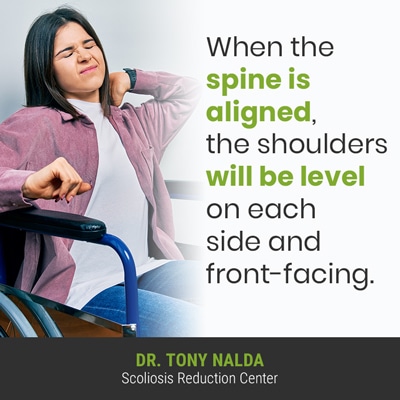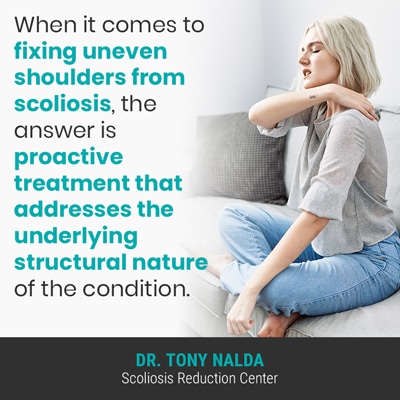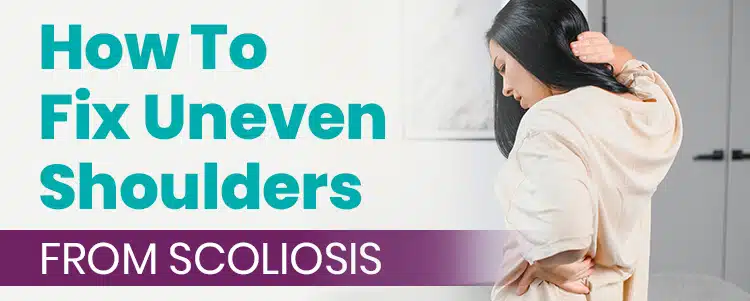Although scoliosis is a spinal condition, its effects can vary from patient to patient and aren’t just isolated to the back. As an unnatural spinal curve develops, it disrupts the body’s overall symmetry, and when it comes to addressing postural deviation such as uneven shoulders, the key is proactive treatment that addresses the condition’s underlying structural nature.
Scoliosis, as an unnatural sideways spinal curve, introduces a lot of uneven forces to the body. In children and adolescents, the main scoliosis symptom is postural deviation, and often, the condition’s earliest indicators are uneven shoulders and hips.
Scoliosis can affect the body in a multitude of ways, including postural changes, but let’s start with what it means to be diagnosed with scoliosis.
Being Diagnosed with Scoliosis
Being diagnosed with scoliosis means a progressive structural spinal condition has developed.
Scoliosis involves the development of an unnatural sideways spinal curve that also rotates, and has a minimum Cobb angle of 10 degrees.
Cobb angle is a measurement taken during X-ray that tells me how far out of alignment a scoliotic spine is.
When the spine’s natural and healthy curves are in place, the vertebrae (bones of the spine) are in a straight and neutral alignment, and they make the spine stronger, more flexible, and better able to facilitate the even distribution of mechanical stress.
When an unnatural spinal curve develops, certain vertebrae become tilted, shifting out of alignment with the rest of the spine, and a misaligned spine is one that’s not going to function optimally.
A patient’s Cobb angle measurement also shapes the design of effective treatment plans because it classifies conditions based on severity:
- Mild scoliosis: Cobb angle measurement of between 10 and 25 degrees
- Moderate scoliosis: Cobb angle measurement of between 25 and 40 degrees
- Severe scoliosis: Cobb angle measurement of 40+ degrees
- Very-severe scoliosis: Cobb angle measurement of 80+ degrees
In general, the higher the Cobb angle, the more severe the condition, and the more likely it is to cause noticeable postural changes.
Another key condition feature is its progressive nature, meaning that it will get worse over time, particularly if left untreated, or not treated proactively.
Where a scoliosis is at the time of diagnosis, and where a person’s posture is, is not indicative of where it will stay; only proactive treatment can work towards counteracting the condition’s progressive nature.
In addition to the wide-ranging severity levels of scoliosis, there are also different condition types, the most common being adolescent idiopathic scoliosis (AIS), diagnosed between the ages of 10 and 18, which is the form we’re currently focusing on.
So let’s start talking about scoliosis symptoms, one of which is postural deviation, such as uneven shoulders.
Common Scoliosis Symptoms in Adolescents
The idiopathic designation in adolescent idiopathic scoliosis means we don’t fully understand why it initially develops, but that doesn’t mean we don’t know how to treat it, and that also doesn’t mean we don’t understand what triggers its progression: growth and development.
Considering the stage that adolescents are in (puberty), or are entering into, at the time of diagnosis, this age group is at risk for rapid-phase progression.
When it comes to AIS, the condition’s early telltale signs are often uneven shoulders and hips, and this is due to the condition’s uneven forces.
In addition, scoliosis is known to cause the following symptoms in adolescents:
- Uneven shoulder blades
- The development of a rib arch
- An uneven waistline
- Uneven hips
- Arms and legs that appear to hang at different lengths
In addition to the aforementioned postural changes, changes to gait, balance, coordination, and clothing suddenly seeming ill-fitting can be additional condition indicators that warrant the need for further testing.
While there are no treatment guarantees, with early detection and a proactive conservative treatment approach, there are few limits to what we can achieve, and the reality is that most cases of scoliosis can be treated nonsurgically.
So why does scoliosis cause uneven shoulders, and how are they fixed?
Scoliosis Uneven Shoulders
There are three main spinal sections, and scoliosis can develop in any one section, or more than one as a combined scoliosis: cervical spine (neck), thoracic spine (middle/upper back), and the lumbar spine (lower back).
While each case is unique, generally, the section of the body most closely located to the spinal section affected is going to experience the most direct effects.
For example, when it comes to shoulder pain and uneven shoulders, this is most closely tied to thoracic and cervical scoliosis because it involves the upper sections of the spine, and the shoulders are located nearby as part of the upper body.

When the spine is aligned, the shoulders will be level on each side and front-facing.
When a structural issue like scoliosis comes into play, one shoulder can end up sitting higher than the other, with one shoulder blade protruding more on one side than the other.
If the shoulders are uneven, neck, shoulder, shoulder blade, and lower back pain can develop, and these symptoms increase if other bodily asymmetries are present, as is common with scoliosis.
Shoulder pain can feel like excessive tightness, soreness, and a pulling sensation is often felt in the shoulder sitting higher.
The shoulders can also take on a more rounded-forward appearance and feel like a knot is always present.
Shoulder pain is most closely associated with scoliotic curves in the upper back as this means the muscles of the upper back are working harder to support the unnaturally-curved section of the spine.
How to Fix Uneven Shoulders from Scoliosis

When it comes to fixing uneven shoulders from scoliosis, the answer is proactive treatment that addresses the underlying structural nature of the condition.
Scoliosis is a structural condition, meaning it involves a structural abnormality within the spine itself (the tilted vertebrae), so in order to treat it effectively, it has to be, primarily, impacted on a structural level.
Here at the Scoliosis Reduction Center®, I apply a conservative chiropractic-centered treatment approach started as close to the time of diagnosis as possible; this is valuable because scoliosis is simpler to treat early in its progressive line, when it’s going to be the most responsive to treatment.
As scoliosis progresses, the spine gets more rigid, making it less responsive to chiropractic care and making certain physical therapy techniques and exercises more difficult to perform.
First, I start with a series of chiropractic adjustments and techniques to work towards repositioning the position of the curve’s most-tilted vertebrae at its apex.
By addressing areas of vertebral subluxation, the spine is realigned, and this means the spine’s natural curves are restored as the condition’s uneven forces that cause postural deviation are also reduced, improving postural changes.
Once I see structural results, I shift the treatment focus to increasing core strength through physical therapy and scoliosis-specific exercises; a spine that’s surrounded by strong muscles is one that’s receiving optimal support and stabilization.
Corrective bracing is particularly effective on growing spines, and the ScoliBrace is my corrective brace of choice for adolescents; bracing can help augment corrective results by pushing the spine into a corrective position.
The final phase of treatment is rehabilitation, and this involves a series of custom-prescribed home exercises so patients can establish a rehabilitation program from home to further stabilize the spine for long-term sustainable treatment results.
By combining multiple condition-specific treatment disciplines and customizing treatment plans to address key patient/condition variables, scoliosis can be impacted on every level, which is precisely what its complex nature needs.
When it comes to condition-related postural deviation, the key is to address its underlying cause: the structural spinal condition.
By proactively treating scoliosis through reducing the curve and increasing core strength, as the condition’s uneven forces are improved, so too are its symptoms, such as uneven shoulders.
Conclusion
So when it comes to addressing which shoulder is higher in scoliosis, the answer will be case specific; in typical curves that bend to the right, away from the heart, the right shoulder will be higher, and in atypical curves that bend to the left, the left shoulder will be higher.
Uneven shoulders are caused by the uneven forces scoliosis introduces to the body, and in children and adolescents, postural deviation is the main symptom; in fact, the earliest signs of scoliosis are often uneven shoulders and hips.
When the spine is aligned, the shoulders sit level with one another and are front-facing, but when the spine shifts out of alignment, due to the development of a scoliotic curve, one shoulder tends to sit higher, while the other is pushed down.
Uneven shoulders can be painful, and the best way to address this postural change is through proactive treatment that, first and foremost, impacts the condition on a structural level, in the form of a curvature reduction.
By working towards a curvature reduction, this means the spine’s misalignment is being addressed, which is the underlying cause of uneven shoulders.




